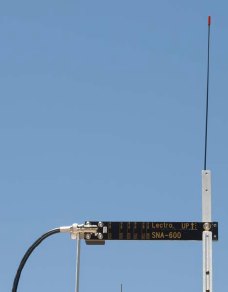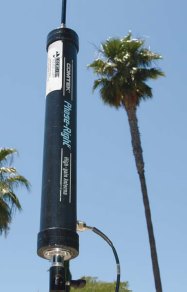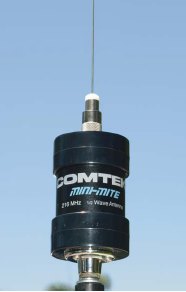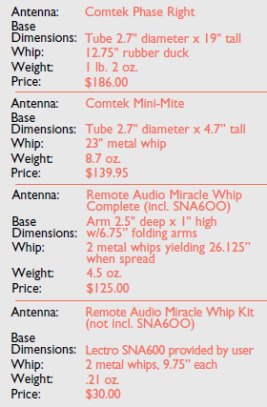Remote Audio sent us their version of a Comtek antenna, the Miracle Whip MW216, for evaluation as part of our sequence of antenna test articles. Since Comtek recently brought out the Mini-Mite, a smaller variation on their Phase Right series of antennas, it seemed a good time to turn our attention from receiving to transmitting antennas.

The Miracle Whip name sounds like it should be part of a tuna sandwich but it’s a Lectrosonics SNA600 UHF dipole modified to operate at lower frequencies. Coated wires cut to the proper length attach to the folding wings of the SNA to tune the antenna to the 216-217 MHz band used by the base station transmitters. It’s cleverly designed so the extensions mount using existing threaded holes on the SNA600. The resulting antenna retains the ability to fold for transport and is much smaller and lighter than the Comtek Phase Right antenna commonly paired with the base station transmitters. It is a bit more “prickly” but that’s probably not a serious liability in actual use.
It performed very well in tests although not any better than the alternatives. We set up our usual test walk and measured how far we could get from the Comtek BST-25 base station before the signal degraded. We ran all the tests in the lower channels, the “Narrow Band.” The “High Band” above Ch. 40 might offer improved range but relative performance should be the same. There was a pattern of performance typical to all the antennas we tested: the signal would be very clean for about 250–300 feet and then a thin swirl of background hash would creep in. This background hash can float in and out and is well below voice levels; it might pass unnoticed in a scene with active talking. Vulnerability to hits and dropouts became pronounced around 550 feet although we had some test runs that were OK out to 700 feet. As always, we maintained good line of sight between the antennas and suspended testing if any bogeys wandered into the testing area. Performance on an actual set with crew people moving about is likely to be less.
We were surprised that we achieved some of the best performance with the telescoping antenna that comes packaged with the transmitter. In several test runs, it was consistently artifact-free to about 400 feet and maintained good signal to at least 550 feet. The other antennas sometimes exceeded that range but, in the first series of tests, all exhibited the floating hash 50 or 100 feet earlier. The base station was three feet above ground on the shelf of a Mag-liner cart for these tests.

The Comtek Phase Right and the Miracle Whip antennas had very similar performance. They were connected to the transmitter by six feet of RG-8X cable and held aloft by a C-stand. Height was adjusted so the center point of the antenna would be six feet above ground. We had clean transmission from both for at least 250 feet. The thin background hash became noticeable somewhere between 250 and 350 feet and we began to experience hits and dropouts around 500 feet but occasional test runs were OK to 600 feet and beyond. The results of multiple test runs sometimes favored the Comtek and sometimes the Miracle Whip.
We had an old VHF Phase Right on hand and tried it out. Although tuned to 169 MHz, it worked very nearly as well as the others. We made only a couple of runs with this “off label” use but achieved clean operation free of background hash to 270 feet. Performance was slightly degraded starting around 355 feet but we didn’t experience significant dropouts until 540 feet. Tuning to exactly 215 MHz does not appear to be critical in this application although the others did have about 10% or 15% better range. It wouldn’t be the best choice if you were buying fresh but it could be used successfully if you already have one in your kit.

We acquired a Mini-Mite for a second round of tests. This new design from Comtek is a half-wavelength dipole with a tube base, like the Phase Right but much shorter. Rather than a “rubber-duck” antenna extension, it comes fitted with a 23-inch rigid wire whip.
Performance of the Mini-Mite was consistently good. We achieved at least 300 feet before hearing any artifacts and twice recorded 400 feet of clean range. The signal became vulnerable to hits around 500 feet but would continue to be usable out to 600 or 650 feet. On one occasion, we walked more than 700 feet before we deemed the results unacceptable.
We also had good results that day from the Remote Audio Miracle Whip, observing clean signal out to 400 feet. Performance was a bit “iffy” but usable from 475 feet and didn’t become unacceptable until 630 feet.
Each test walk yielded slightly different results that would favor first one design and then the other. The overall pattern was very similar. Audio was clean to at least 300 feet, vulnerable but still usable starting around 450 feet and significantly compromised from about 600 or 650 feet.

Although the Phase Right, the Mini-Mite and the Miracle Whip do not seem to offer any performance benefit over the standard antenna, they do serve a useful function. Optimum performance from the telescoping antenna requires locating the transmitter on a top shelf of the cart so there is room to extend it. The remote antennas achieve good performance with the transmitter more conveniently located.
Since the performance is so similar, it makes some sense to choose based on size and weight considerations and price. At $186, the Phase Right is the most expensive of the bunch and its 19-inch tube base makes it a bit unwieldy. The Mini-Mite is less expensive, performs at least as well and is considerably smaller. Weighing only 4.5 oz, the Miracle Whip is the smallest and lightest antenna we tested and also the least expensive.
Acknowledgments
We are grateful to Glen Trew and Jane Baxter at Trew Audio and Josh Harper of Remote Audio for supplying the Miracle Whip, to Robert Anzalone in the Location Sound Corporation Rental Department for the loan of Comtek equipment and to Will Tarr in LSC Weights and Measures for his assistance. And, as always, we owe a debt of gratitude to Scott Harris, who supplied the measuring wheel and all of the grip support gear and actually walked many of the tests.